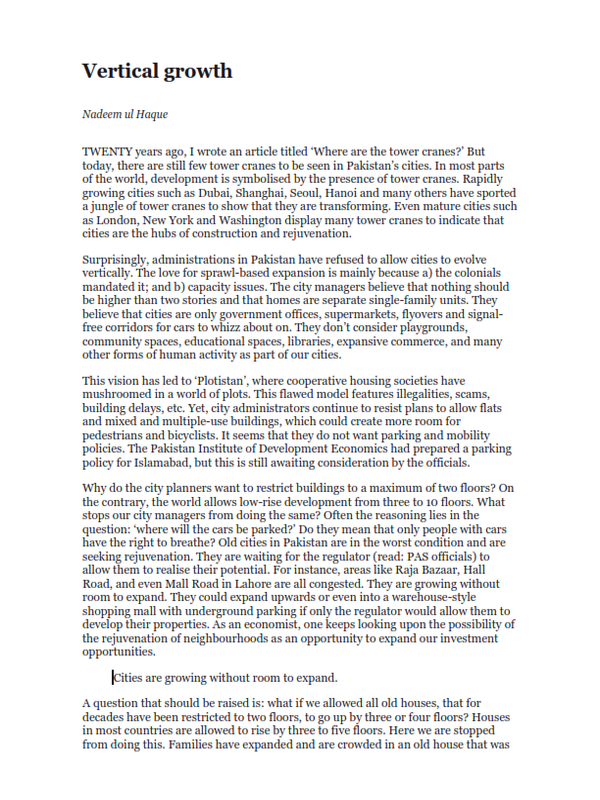Vertical Growth
TWENTY years ago, I wrote an article titled ‘Where are the tower cranes?’ But today, there are still few tower cranes to be seen in Pakistan’s cities. In most parts of the world, development is symbolised by the presence of tower cranes. Rapidly growing cities such as Dubai, Shanghai, Seoul, Hanoi and many others have sported a jungle of tower cranes to show that they are transforming. Even mature cities such as London, New York and Washington display many tower cranes to indicate that cities are the hubs of construction and rejuvenation.
Surprisingly, administrations in Pakistan have refused to allow cities to evolve vertically. The love for sprawl-based expansion is mainly because a) the colonials mandated it; and b) capacity issues. The city managers believe that nothing should be higher than two stories and that homes are separate single-family units. They believe that cities are only government offices, supermarkets, flyovers and signal-free corridors for cars to whizz about on. They don’t consider playgrounds, community spaces, educational spaces, libraries, expansive commerce, and many other forms of human activity as part of our cities.
This vision has led to ‘Plotistan’, where cooperative housing societies have mushroomed in a world of plots. This flawed model features illegalities, scams, building delays, etc. Yet, city administrators continue to resist plans to allow flats and mixed and multiple-use buildings, which could create more room for pedestrians and bicyclists. It seems that they do not want parking and mobility policies. The Pakistan Institute of Development Economics had prepared a parking policy for Islamabad, but this is still awaiting consideration by the officials.
Why do the city planners want to restrict buildings to a maximum of two floors? On the contrary, the world allows low-rise development from three to 10 floors. What stops our city managers from doing the same? Often the reasoning lies in the question: ‘where will the cars be parked?’ Do they mean that only people with cars have the right to breathe? Old cities in Pakistan are in the worst condition and are seeking rejuvenation. They are waiting for the regulator (read: PAS officials) to allow them to realise their potential. For instance, areas like Raja Bazaar, Hall Road, and even Mall Road in Lahore are all congested. They are growing without room to expand. They could expand upwards or even into a warehouse-style shopping mall with underground parking if only the regulator would allow them to develop their properties. As an economist, one keeps looking upon the possibility of the rejuvenation of neighbourhoods as an opportunity to expand our investment opportunities.
Cities are growing without room to expand.
A question that should be raised is: what if we allowed all old houses, that for decades have been restricted to two floors, to go up by three or four floors? Houses in most countries are allowed to rise by three to five floors. Here we are stopped from doing this. Families have expanded and are crowded in an old house that was meant for a small nuclear family. Why not let them build and live more comfortably?
Currently, one can’t build upwards in the inner city but must wait for housing colonies to develop way outside the cities. Housing societies take years to develop and are often characterised by fraud and delays. Moreover, they are located miles outside the city and far from the places where people have lived their lives. It takes a lifetime to make this costly transition. Meanwhile, family savings tied up in risky housing schemes can be lost.
Having initiated a debate on high-rises and flats some 30 years ago, I realise now that what is missing is the middle — letting people develop ancestral properties to develop their neighbourhoods. This will unlock investment and employment opportunities and allow cities to develop without the dislocation of people and neighbourhoods. Allowing the middle to develop will promote well-being at every level.
PAS city managers should allow the middle to develop. All it takes is a rule change. Remove the two-floor restriction and let people go up two to three floors higher. Of course, some may not be able to go higher given the state of their construction. But otherwise, let each family decide. This is also a simple solution to the housing shortage in the country.
This proposal may not fit in well with the current silly requirement that cars must be accommodated before people. But even in congested areas, people manage to park their cars. Let floors be built and let people use paid street parking or parking lots.
The writer is vice chancellor of the Pakistan Institute of Development Economics, and former deputy chairman of the Planning Commission of Pakistan.
Published in Dawn, November 16th, 2022




